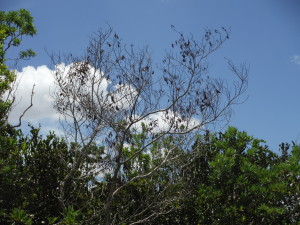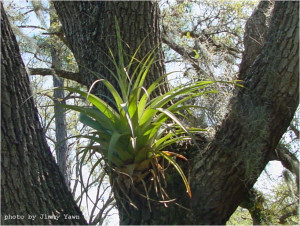The World Conservation Union (IUCN) has just released a report, IUCN World Heritage Outlook 2014 (for press release, click here; for the full report, click here)
that names invasive species as the second most significant threat World Heritage sites with outstanding natural values. (Poaching is the greatest threat).
World Heritage sites have “outstanding universal values” – either natural or cultural. Natural sites are areas either of exceptional beauty or representative of major stages of Earth’s history, significant ongoing ecological processes, or significant habitats for biodiversity and threatened species.
The 2014 assessment examined 229 natural World Heritage sites and found that 104 are affected by invasive species. Unsurprisingly, island sites are especially heavily impacted. Two-thirds of the affected island sites (24 out of 36) are in the tropics.
The most widespread or common invaders are plants; they are named in 55 of the 104 affected sites. Invasive vertebrate animals affect at least 12 sites. These frequently include fish (mostly trout), cats, and rodents (especially rats).
The report calls for effective management strategies to protect the World Heritage sites. Such strategies include well-defined plans as well as strict bio-security measures, including limiting materials entering the site or the eradication of problem-causing species. Ideally, these actions involve local communities. Among the 104 natural World Heritage areas affected by invasive species, 87 have management projects addressing at least some invasive species or related issues.
According to the report, future invasive species management will be even more challenging, especially because of climate change. Climate change, itself, could become the biggest threat to natural sites in future.
dead sweetbay in Big Cypress National Preserve, Florida
The United States has 21 World Heritage sites. Nine were chosen for their outstanding natural values. These include the following National parks: Everglades, Grand Canyon, Great Smoky Mountains, Hawaii Volcanoes, Redwood, Yellowstone, and Yosemite National parks; and – jointly with Canada – Kluane / Wrangell-St. Elias / Glacier Bay / Tatshenshini-Alsek and Waterton-Glacier National parks.
Several of these natural wonders are well known to be threatened by invasive species – including some tree-killing insects and pathogens.
Everglades National Park. In Everglades, pythons have decimated populations of small to medium native mammals. Lionfish are killing vast numbers of fish in the shallow bay. Numerous invasive plants, especially Australian pine, Melaleuca, Brazilian pepper, and old world climbing ferns transform the natural sawgrass prairie and mangroves. Some, e.g., Melaleuca, are under control thanks to persistent effort over decades.
Laurel wilt has almost eliminated swamp bay trees from the hammocks. Bromeliad weevil has killed many bromeliads in 12 genera (of the 16 present in Florida).
Tillandsia utriculata bromeliad in Florida
Great Smoky Mountains National Park. The outstanding biological diversity of the forested Great Smoky Mountains National Park has been severely undermined by chestnut blight, hemlock woolly adelgid, balsam woolly adelgid; and is now under attack by more recent invaders, including beech bark disease, emerald ash borer, and thousand cankers disease of walnut. Descriptions of all these pests are available here. At ground level, feral hogs damage plants, soil-dwelling invertebrates and small vertebrates, even birds. Rainbow trout compete with native trout in the streams. More than 380 non-native plants compete with the native species. The Park’s website features another invader, the Asian jumping worm (Amynthas agrestis), which has been introduced through bait.
The Great Smoky Mountains are the center of biological diversity for salamanders which are likely soon to face danger from the “Bsal” pathogen – unless the Fish and Wildlife Service acts to restrict imports of salamanders by the pet trade. See how CISP tries to counter this threat.
Hawaii Volcanoes National Park. As I wrote in my blog of October 7, Hawaii Volcanoes National Park is fighting feral hogs, goats, and a plethora of invasive plants (the Park’s flora contains nearly twice as many exotic flowering plants as native species). The Park’s birds are threatened by two non-native diseases, avian pox and avian malaria. As noted in the earlier blog, Hawaii Volcanoes has also been invaded by koa wilt and `ohi`a rust; and is about to be invaded by `ohi`a wilt.
Web-based information from several parks in the western part of the continent focuses on the threat from invasive plants: Grand Canyon, Olympic, Yellowstone, and Yosemite. Redwoods National Park notes the damage caused by sudden oak death to its principal hardwood species, tanoak. Yellowstone National Park has a website describing its whitebark pine forests and mentioning that up to 30% of the taller whitebark pines have been attacked by white pine blister rust; I could find little information about the disease’s impact on the Park’s limber pines, which are also susceptible.
Yosemite National Park has a website with a table listing 16 non-native insects and pathogens that could threaten trees in the park. White pine blister rust is already present in the Park’s sugar pines. I am pleased to see that the website features goldspotted oak borer and the risk of pest introduction via firewood. I just wish Yosemite actually prohibited visitors from bringing firewood into the Park! And carefully restricted commercial suppliers! I addressed Yosemite’s failure to protect itself in my blog of 10 August.
The National Parks Conservation Association is the principal NGO that advocates for protection of the National parks. It issued a report in 2008 that found invasive species were a limited concern in 90% of the parks evaluated, a widespread or chronic concern in 38%. In Hawaii Volcanoes specifically, the natural resources were ranked in “poor” condition due primarily to non-native plants and animals.
Many individual parks have “Friends” groups ….
I ask these groups to help the National parks counter invasive species. To be effective, they need to go beyond the many volunteer “weed pulls” and outreach programs educating park visitors who might transport invasive species (for example, boaters and fishermen who can spread New Zealand mudsnails, rock snot, and invasive mussels; and campers who carry firewood that can transport pests). I ask them to also lobby for policies that would prevent invasions and for increase funding for the parks’ resource management programs (the programs that tackle invasive species). I suggest specifically that supporters of National parks advocate for improvements in programs run by the USDA’s Animal and Plant Health Inspection Service or the U.S. Fish and Wildlife Service. These agencies, more than any other, determine whether prevention succeeds or fails.
Posted by Faith Campbell

